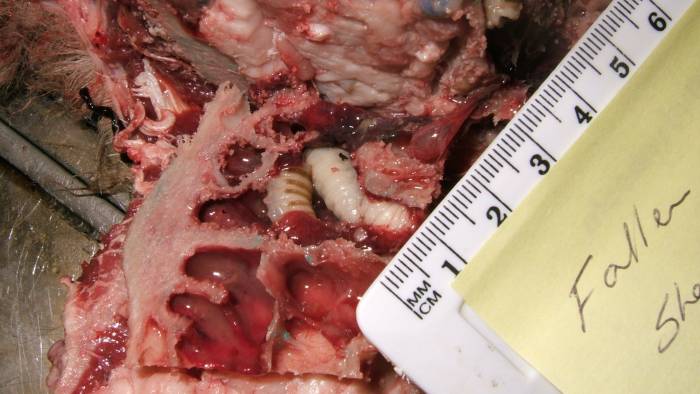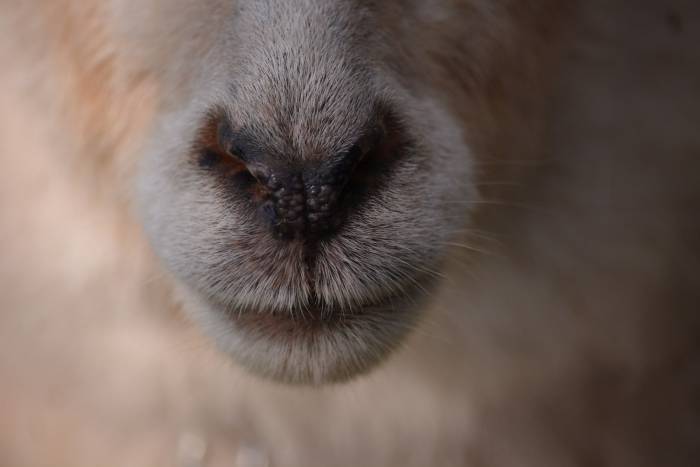Sheep nasal bots (Oestrus ovis) are fly larvae that develop in the nasopharyngeal cavities of sheep and goats. They have well-developed mouth-hooks to aid attachment and feeding. The adults do not feed, have non-functional mouthparts and are short-lived.
Adult flies approach the host’s nostrils and, while still in flight or after landing briefly, they squirt about 20 live first-stage larvae into the nostrils of the host. The larvae, described as bots, crawl into the nasal cavities, where they feed and develop for a month, before moving into the frontal, and sometimes the maxillary, sinuses.
When fully developed, the larvae migrate back towards the nasal cavities from where they are sneezed or coughed out onto the ground. Once on the ground the larvae burrow into the soil, pupate and eventually emerge as the next generation of flies.
In northern Europe, the first adults of the year emerge in late spring and start to larviposit on their hosts shortly after. This first generation of larvae develop rapidly, leaving the host in July and August and leading to an autumn generation of adult flies. The larvae produced by the autumn flies overwinter within the host in a state of arrested development and only become mature the following spring, then giving rise to the early summer generation of adults.
The presence of larvae in the nostrils irritates the mucosa, resulting in a sticky, mucoid nasal discharge which at times may be haemorrhagic and may cause impaired respiration. Infestation may result in reduced weight gain in lambs, losses in wool production and a reduction in milk production. However, in general, infestations are relatively light with an average of only two to 20 larvae per host.
Clinical signs of light infestation include mild discomfort, nasal discharge, sneezing, nose rubbing or head shaking. Occasionally dead larvae in the sinuses can cause allergic and inflammatory responses followed by bacterial infection and, possibly, death. Very rarely, larvae may penetrate the olfactory mucosa of turbinates and enter the brain, leading to ataxia, circling and head pressing.
Although sheep and goats are the main hosts for O.ovis, infestation occasionally occurs in dogs and humans; in humans, infestation is usually in the eye. However, in these hosts larvae do not complete their development.
The adults are particularly active during hot, dry weather and their activity often leads to considerable disturbance, with sheep attempting to keep their nostrils pressed against the ground to protect themselves from the adult flies. Similarly, infestation prevalence is highly dependent of climate; flock infestation rates of up to 100% have been recorded in North Africa, 44–88% in southern France, but may be as low as 0.75% in southern Britain. This pattern suggests infestation by nasal bots is likely to be highly influenced by climate change and that, in the future, warming summers and extended warm weather into autumn, will be expected to increase the future risk from this parasite in the UK.
Control of the adult flies is impractical, as species-specific fly traps are not available and fly repellents have limited effect. Control of the larvae can be achieved by the treatment of hosts with systemic drugs, including macrocyclic lactones, such as ivermectin, doramectin and moxidectin. However, where the numbers of larvae are small, it may not be necessary, desirable or economically viable to treat infected animals. General flock prophylactic treatment should be avoided where possible, because of the increased risk of selection for resistance in other endo and ectoparasites and environmental impacts.
Treatment should, ideally, be based on clinical signs and an assessment of risk in individual animals. If the risk is perceived to be high, flock treatment can be given twice a year (at the beginning of summer to kill newly acquired larvae and again in midwinter to kill any overwintering larvae). However, to avoid unnecessary treatments, farmers are urged to discuss with their vet or animal health adviser before carrying out any flock level treatments.

